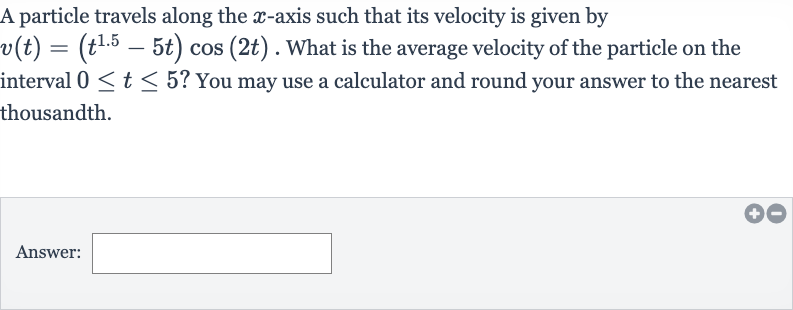Full solution
Q. A particle travels along the -axis such that its velocity is given by . What is the average velocity of the particle on the interval ? You may use a calculator and round your answer to the nearest thousandth.Answer:
- Calculate Average Velocity: To find the average velocity of the particle over the interval from to , we need to calculate the total displacement over the time interval and then divide by the total time. The average velocity () is given by the formula:First, we need to find the displacement by integrating the velocity function from to .
- Integrate Velocity Function: We integrate the velocity function with respect to from to . This requires using integration techniques that may involve integration by parts, trigonometric identities, or substitution. Since the problem allows the use of a calculator, we will compute the integral using a calculator.
- Find Displacement Value: Using a calculator, we find the integral of from to . This will give us the displacement of the particle over the time interval.
- Calculate Average Velocity: After calculating the integral, we find the displacement value at . Let's denote this value as . We do not need to find the displacement at , because the integral of any function from to is zero, so .
- Plug in Values: Now we calculate the average velocity using the displacement and the time interval, which is seconds. The formula for average velocity is:
- Round to Nearest Thousandth: We plug the value of obtained from the calculator into the formula and divide by to get the average velocity. We round the answer to the nearest thousandth as instructed.
- Round to Nearest Thousandth: We plug the value of obtained from the calculator into the formula and divide by to get the average velocity. We round the answer to the nearest thousandth as instructed.Let's assume the calculator gave us a value of (where is the result of the integral calculation). Then the average velocity would be:We round this value to the nearest thousandth.
More problems from Relate position, velocity, speed, and acceleration using derivatives
QuestionGet tutor help
QuestionGet tutor help
QuestionGet tutor help
QuestionGet tutor help
QuestionGet tutor help
QuestionGet tutor help
QuestionGet tutor help
QuestionGet tutor help
QuestionGet tutor help

